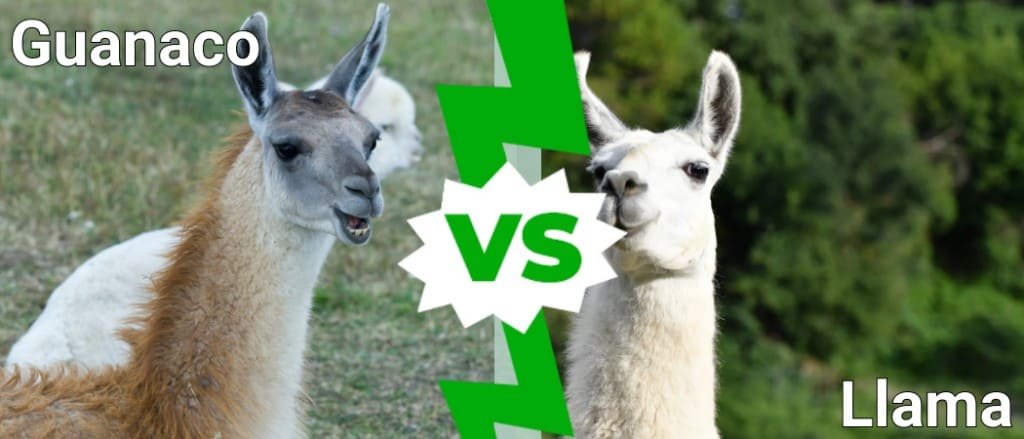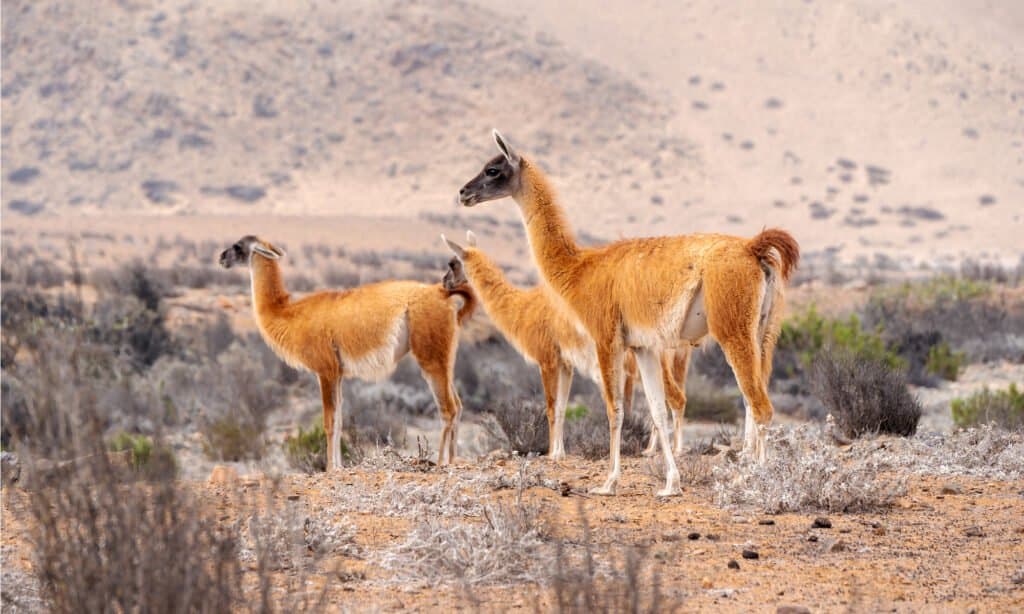Guanacos and llamas are both members of the Camelidae family that live in the high elevations of South America. They are incredibly similar animals with a lot in common. In fact, the differences between guanacos and llamas may not have existed only a few thousand years ago as llamas are direct descendants of them. Let’s explore: Guanaco Vs Llama; what makes them different?
Comparing A Guanaco And A Llama

| Guanaco | Llama | |
| Size | Weight: 200-310 lbs | Weight: 280-450 lbs |
| Color variations | Light brown, dark cinnamon, white underbellies | Brown, white, grey, piebald, spotted |
| Ears | Smaller, thinner ears | Thicker, broader ears |
| Domestication | Not domesticated, hunted for resources | Domesticated for 5,000 years |
| Fur quality | High-quality, some of the best in the world | Good quality fur, rougher than alpaca and guanaco |
| Evolutionary history | Camelid, ancient precursor to the llama | Camelid, domesticated from wild guanaco |
The 6 Key Differences Between Guanacos and Llamas
The primary differences between guanacos and llamas are their size, colorations, and domestication features. Guanacos are some of the largest wild animals in South America. Llamas are domesticated and primarily used as pack animals. As a result, llamas are larger because they were selected for size. Additionally, guanacos only come in a few shades of brown with white underbellies, while llamas come in a whole array of colors and variations.
Finally, the main difference between the two is domestication and its effects. Guanacos are wild, and their behavior and adaptations reflect that. Llamas are domesticated and, as a result, depend on humans, resulting in marked changes physically and behaviorally.
Let’s explore these differences, as well as a few others, in more detail below.
Guanaco Vs Llama: Size

Compared to llamas, guanacos are much smaller weighing between 200 to 310 pounds.
©oscargutzo/Shutterstock.com
Guanacos are smaller than the average llama. Generally, guanacos weigh 200-310 lbs and are a little less than 4 feet tall at the shoulder. They are slender animals with long legs and long necks. Additionally, they are sexually dimorphic, with the males being a bit larger than the females. Guanaco are some of the largest wild animals in South America. Only certain species of tapir are larger than guanaco.
Typically, llamas are larger than guanaco, likely a result of unlimited food resources and selective breeding for pack animal traits. On average, llamas can weigh 280-450 lbs, with some getting even larger. Together, llamas and guanacos make up some of the largest terrestrial animals in South America.
Guanaco Vs Llama: Color variations
Guanacos are known for their brown fur and white underbellies. The few variations, usually cinnamon brown or a slightly darker shade, are likely due to the needs of the guanaco. Since they are wild animals, they need to blend in with their surroundings.
Llamas are much more varied when it comes to coat colorations. As llamas are domesticated, the need for specially adapted coats to blend in was no longer needed, reducing the selection pressure. Additionally, llamas have been selectively bred, making different colors much more common and valuable. Llamas can come in shades of black, white, brown, grey, spotted, speckled, piebald, and more. In some places, selective breeding has allowed farmers to choose the color of future herds through genetic selection.
Guanaco Vs Llama: Ears
Outside of color, one of the easier ways to differentiate a guanaco from a llama is their ears. Guanacos have shorter, thinned ears than the llama. Llama ears are generally longer and quite a bit more distinctive. “Llama ears” even have a place in some cultures and children’s games.
Guanaco Vs Llama: Domestication

Llamas are simply the result of 5,000 years of guanaco domestication.
©Cezary Wojtkowski/Shutterstock.com
The major difference between the two species of Camelid is their domestication. Guanacos are not domesticated and have wild herds roaming across much of South America. These herd animals were captured by native peoples over 6,000 years ago and farmed. Over thousands of years, the modern llama entered the scene around 5,000 years ago. Although they are closely related, they share some differences as a result of domestication.
Domestication changes more than just the physical features of an animal. Behaviorally, llamas are gentle and well adapted for life around humans. They are known to detect emotional pain and even comfort people, explaining their use in many hospitals (therapy llamas are actually a thing). Additionally, their aggression is low, especially among well-socialized individuals.
Physically, domestication allowed llamas to grow larger and come in different colorations. Since llamas were (and are) bred for fur, meat, milk, and hides, having more and greater variation of those resources was valuable. Additionally, since llamas were used extensively as pack animals, they were bred to be larger and to carry more weight.
Guanaco Vs Llama: Fur quality
Although the quality of something is rather subjective, there are some differences between the fibers of the two animals that are worth noting. Guanaco is wild and, therefore, harder to get. Additionally, their wool is finer and softer, especially the undercoat. Llama hair comes in more natural colors, but it is known to be a bit rougher. Still, the wool of both animals is valuable. Of all the South American camelids, the vicuña is known to have the finest of them all.
Guanaco Vs Llama: Evolutionary history
Guanaco and llama share a close evolutionary history. Both animals are members of the Camelidae family, along with five others, camels among them. Their ancient ancestors arrived in South America tens of thousands of years ago from North America. However, the northern groups died out during the last ice age, leaving only the South American groups alive.
Guanacos were captured and used by humans as long as 7,000 years ago, making them one of the earliest animals to be domesticated, especially in the New World. The domesticated result of farming guanaco for meat, fur, milk, and more resulted in the modern-day llama. Llamas are simply the domesticated forms of guanaco (after 5,000 years of intentional selection).
The photo featured at the top of this post is © abriendomundo/Shutterstock.com
Thank you for reading! Have some feedback for us? Contact the AZ Animals editorial team.






